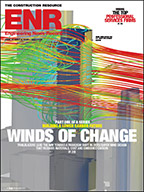The Council on Tall Buildings & Urban Habitat is vigorously advancing its mission—to help upgrade skyscraper production by offering better design tools and standardizing practice worldwide. In a fundamental shift, the 42-year-old CTBUH is engaging in research, including a $2-million fire study that will culminate in a real building burn.
Next year, CTBUH plans to publish five design guidelines on wind-tunnel testing, structural outriggers, performance-based seismic design, column shortening, foundations and natural ventilation. “There is a need for better tall buildings around the world,” said Antony Wood, CTBUH's executive director, at the CTBUH 2011 World Conference in Seoul. The Oct. 10-12 conference drew about 800 registrants from 40 nations.
During Wood's five-year tenure at the council, membership has quadrupled. “If you add up the number of staff in our member firms, we reach about 500,000 people,” said Wood, also an associate professor of design at the council's home, Chicago's Illinois Institute of Technology.
Close to 70% of CTBUH members are outside the U.S., and 90% of the 10 tallest buildings under construction are outside the U.S., says CTBUH.
Asia still leads the supertower boom, followed by the Middle East. The tallest tower under way, but still not above grade, is the 660-meter PingAn Finance Center in Shenzhen, China, set to open in 2015. Trailing PingAn is the 632-m Shanghai Tower, a mixed-use structure set for completion in 2014 (ENR 7/26/10 p. 24).
The 601-m Makkah Royal Clock Tower Hotel in Saudi Arabia is next on the list, but way ahead of the pack. When completed at year's end, it will rank as the second-tallest building in the world, after the 828-m Burj Kalifa in Dubai.
New York City's 541-m One World Trade Center, set to open in 2013, is the only U.S. tower in the top 10 (ENR 8/15 p. 40). It is ranked sixth, after the 597-m Goldin Finance 117 in Tianjin, China, and the 556-m Lotte Jamsil Super Tower in Seoul, which will be South Korea's tallest. One WTC beats the 530-m CTF Guangzhou in China; the 518-m Dalian Greenland Center in Dalian, China; the 510-m Busan Lotte World Tower in Busan, South Korea; and the 500-m Tianjin R&F Guangdong Tower.
The council defines “supertall” as towers taller than 300 m. By CTBUH's count, there are more than 70 towers under way, not including the 28 started but on hold. In a couple of months, the number may increase by one if work begins, as planned, on the one-kilometer-plus Kingdom Tower in Jeddah, Saudi Arabia.
Though the U.S. trails in the supertower race, U.S. firms, working with local partners, dominate global design. PingAn and Lotte Jamsil are designed by Kohn Pedersen Fox, New York City; Shanghai Tower is designed by Gensler, San Francisco; and Kingdom Tower is designed by Adrian Smith + Gordon Gill, Chicago. Structural design for PingAn, Shanghai Tower and Kingdom Tower is by Thornton Tomasetti, New York City. Leslie E. Robertson Associates, New York City, is the design engineer for Lotte Jamsil.
CTBUH's research and guidance addresses all tall buildings, not just supertowers. Next month, CTBUH kicks off three years of fire research. The aim of the study is to develop a methodology to “adequately and realistically introduce the effects of fire into modern tall-building design.” The output will be a design tool validated against a fire, set for March 2014, in a tall building provided by the Glasgow Housing Authority. The study is directed primarily by the BRE Centre for Fire Safety Engineering, University of Edinburgh. Jose Torero is the principal investigator. Funding is from the U.K. Engineering and Physical Sciences Research Council.










Post a comment to this article
Report Abusive Comment